Trove Newspapers
Access Australian digitised newspapers for free here.
Apply for a library card to access the National Library of Australia’s collection of e-resources, including a wide range of digitised international newspapers from the 18th, 19th and 20th centuries.
Episode list
Nothing on TV is a podcast that ransacks Trove Newspapers, the National Library of Australia’s
online repository of digitised historical newsprint, to present stories from an era when there was
– literally – nothing on TV.
I’ve been writing about Australian history for nearly 30 years, and newspapers have always been a
mainstay of my research. Scouring 19th-century papers, I’ve often been struck by accounts of
immense crowds turning out to witness the merest public spectacle – say, the laying of a foundation
stone for a public building. Thousands, even tens of thousands.
And why? For the same reason you’d have found a pub on every corner: there was nothing on TV.
But there was plenty in the papers. And, thanks to Trove, there still is.
Season Two of Nothing on TV is six episodes in (as of September 2019). Take a listen…
If you come across something intriguing on Trove, feel free to drop me a line via Mrs Bradley.
And remember Mrs B’s motto –
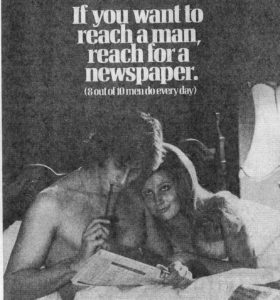
Mr Denning’s Umbrage
Podcast: Play in new window | Download (Duration: 23:50 — 8.7MB) | Embed
Subscribe: Apple Podcasts | RSS | More
Wherein we consider what counts as an amusement…
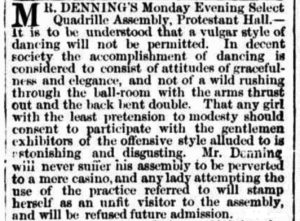
Argus (Melbourne), 22 September 1855, p. 8 (‘Amusements’ column)
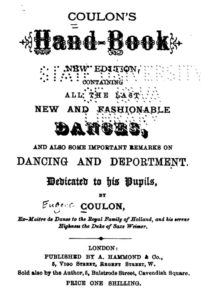
A dance manual by one of Mr Denning’s teachers, Eugene Coulon. Find the full text of
the second edition (c. 1852) here.
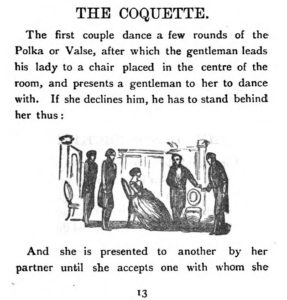
Hm…
A Pig in a Poke
Podcast: Play in new window | Download (Duration: 32:05 — 11.5MB) | Embed
Subscribe: Apple Podcasts | RSS | More
Wherein we plunder suitcases full of mystery…
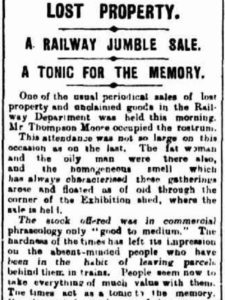
Herald (Melbourne), 18 December 1893, p. 4, col. 5
Here’s a sample of the headlines that would follow railway lost property sales –
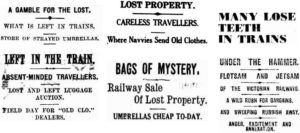
And why not read on – here and here
Moreover, there was this –
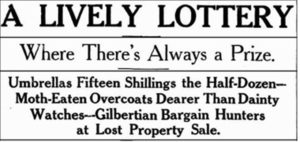 and this –
and this –
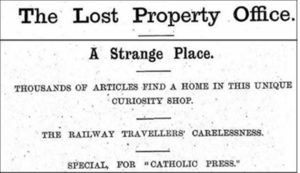
That last item, in The Catholic Press (Sydney) in 1898, noted:
‘That the Lost Property Office has many times been used for the purpose of hiding things in there can
be no doubt. Butler hid Lee Weller’s sea chest and some of his belongings there.’
‘Butler’ was Frank Butler, considered by some to have been Australia’s first serial killer, with Lee Weller
one of his victims. Read about Butler’s crimes and the ‘cloaking’ of Weller’s sea chest here and also here.
The Melbourne Argus (27 July 1923, p. 7) asks a very good question –
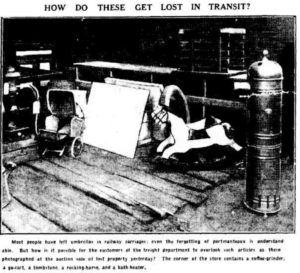
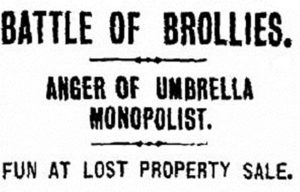
The headline (above) is a ball-tearer – but the text (at Trove Newspapers) is all but illegible.
See if your eyes fare better than mine. (I’d love to know the story.)
There were still umbrellas aplenty on offer at a Sydney lost property auction in 1940 –
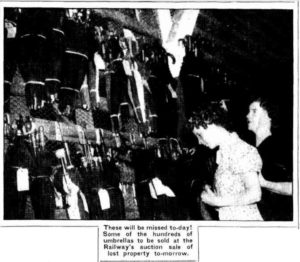
Could the chap in vest and shirtsleeves (below) be the legendary Sid Whittred,
the Queensland Railways auctioneer who ‘never failed to see the funny side of things’?
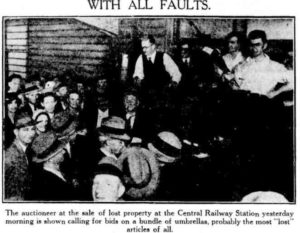
(Brisbane Courier, 26 August 1932, p. 16)
And finally, here’s the link I promised – to ‘The Lost Property Office’, by William G. Fitzgerald,
from The Strand magazine, vol X, July–December 1895. Featuring eye-popping photos taken
inside the lost property depots of the major London railway stations and Scotland Yard,
it’s a real gem. You can find it here, digitised by the Internet Archive.
What is Really Real?
Podcast: Play in new window | Download (Duration: 20:44 — 7.6MB) | Embed
Subscribe: Apple Podcasts | RSS | More
Wherein we shed some light in the phonebox…
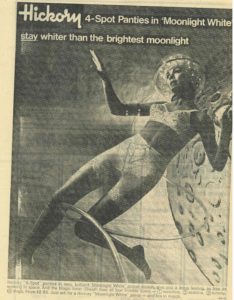
Space travel in the Sun (Melbourne), July 1969.
(Blame the tilt on a lack of gravity)
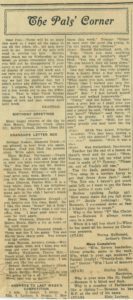
‘The Pals’ Corner’ with ‘Grandad’, Advertiser, 23 June 1933, p. 5
Leaf through the whole issue at Trove Newspapers – including the two missing pages!
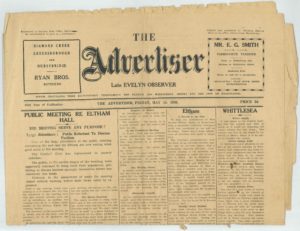
The yawn-inducing headline. Read the paper in its entirety at Trove.
Thanks again to Anwyn and Barb for supplying the ‘really real’ newspapers for this episode.
A Bit of a Ventriloquist
Podcast: Play in new window | Download (Duration: 35:13 — 12.6MB) | Embed
Subscribe: Apple Podcasts | RSS | More
Wherein voices are thrown and pigs educated.
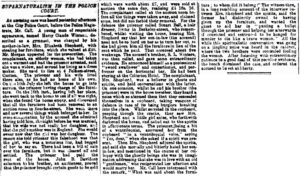
Age (Melbourne), 27 September 1884, p. 10, col. 6
Read it with the rest of the day’s news here.
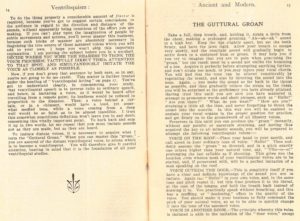
from Ventriloquism: Ancient and Modern – Containing A Complete Explanation
of the Secrets of Ventriloquistic Deception by Richard Hughes, Exchange Press,
264½ Post Office Place, Melbourne, 1902. Anyone wishing to perfect the guttural groan
could do worse than browse the State Library Victoria’s digitised collection,
which includes several manuals of ventriloquism.
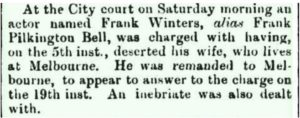
Ballarat Star, 16 April 1888, p. 2, col. 6.
Read it on Trove here.
Frank and Stuart Bell married sisters, Isabel and Rachel Harvey, in 1882-3.
Isabel would die in childbirth in April 1886; the baby boy lived just 11 weeks.
About 18 months later Frank remarried, but the union appears to have been
short-lived –
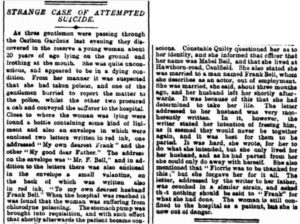
Age (Melbourne), 16 February 1888, p. 5, col. 3 (read it in situ).
‘Florrie was to be thanked for this,’ Mabel wrote. Florrie? Not Florrie Williams, surely?
When the society rag Table Talk reported the incident, it was almost as a cautionary tale –
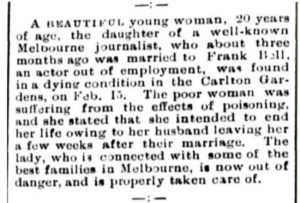
Table Talk (Melbourne), 24 February 1888, p. 14, col. 3
Read the report in situ, nestled amid wedding announcements and accounts of
social success.
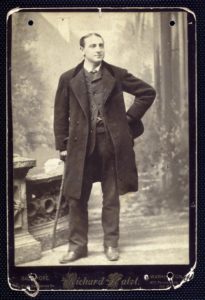
Arthur H. Bell, the eldest, operatic Bell brother.
– from the Billy Rose Theatre Collection, New York Public Library
(Image ID 81284)
This episode of Nothing on TV draws on Victorian and NSW
Births, Deaths & Marriage records available online.
Records for most Australian states are now digitised and
searchable online. Try these links –
Victoria
New South Wales
Queensland
South Australia
Western Australia
Australian Capital Territory (access to some indexes online)
Online access to Tasmanian records isn’t yet available, but is in progress.
Clean Hands
Podcast: Play in new window | Download (Duration: 43:08 — 15.3MB) | Embed
Subscribe: Apple Podcasts | RSS | More
Wherein we consider propinquity of liberty, literacy and soap.
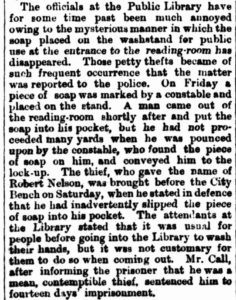
Age (Melbourne), Monday, 17 August 1874, p. 2, col. 6
– read it on the newspaper page here
Joseph Juliff took a penknife to a copy of the Argus in the newspaper
reading room at the Melbourne Public Library – and was caught in the act.
He had thought to expunge the public record of his earlier crime; but it
survives on Trove –
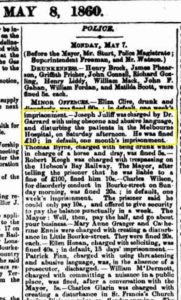
Argus, 8 May 1860, supplement p. 1, col. 5
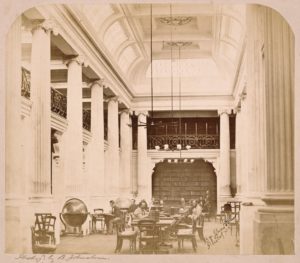
Not a hat in sight: Queen’s Reading Room, Melbourne Public Library, 1859.
Barnett Johnstone, photographer. State Library Victoria Picture Collection
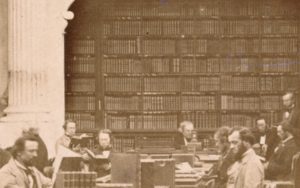
(detail of the above)
‘[E]veryone had the right to go to the shelves and choose his books for himself’
– Sir Redmond Barry
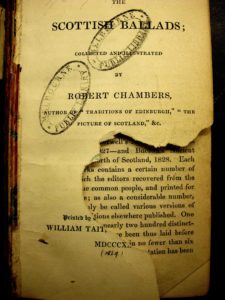
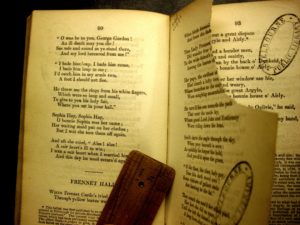
Stolen from the library by ‘a lad’ named George Lindley in 1863,
Chambers’ The Scottish Ballads was ‘considerably disfigured… in his attempts
to destroy the inscriptions which proved it to belong to the library’.
It’s still on the shelf, with Lindley’s handiwork evident at the title page
and page 91. Find it in the SLV catalogue here
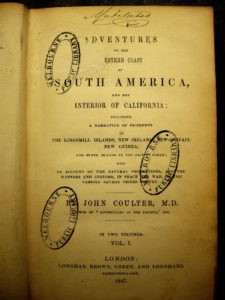
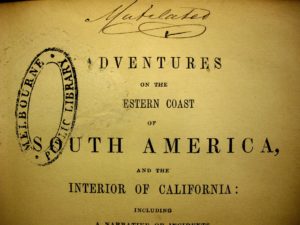
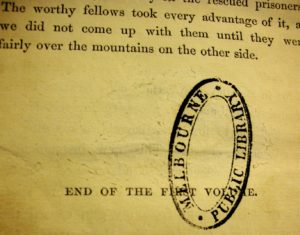
Above are pages from Coulter’s Adventures on the Western Coast of South America, stolen
in 1864 by Henry Williamson and returned to the library ‘mutilated’. Look closely and
you can see where the original library stamps were erased by Williamson, together with
some of the text. This was the book that caused the sardonic barrister Butler Aspinall to
pity the acting librarian for having read. Find it in the SLV catalogue here
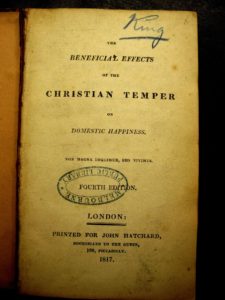
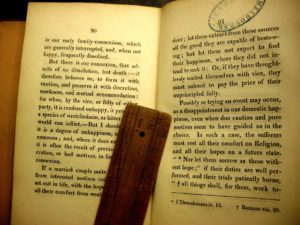
Here’s Mrs King’s The Beneficial Effects of the Christian Temper on Domestic Happiness,
abstracted from the library by W.G. Mitchell, Esq, ‘author of The Mask, &c.’., in 1864
and handed in by his landlady. Page 91 and its stamps are intact, lending credence to
Mitchell’s claim that he had intended to return the book. Find it in the SLV catalogue here
Tin-kettling
Podcast: Play in new window | Download (Duration: 39:05 — 13.9MB) | Embed
Subscribe: Apple Podcasts | RSS | More
Wherein tins and nerves are rattled.
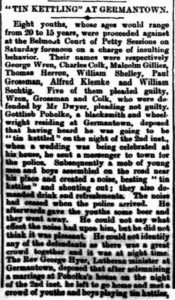
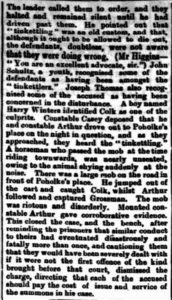
Geelong Advertiser, 12 January 1885, p. 3, cols. 4-5
See the rest of that day’s news here
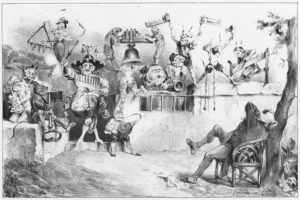
A bawdy depiction of charivari by the French caricaturist J.J. Grandville.
It appeared in the journal La Caricature in 1831.
Here’s a rare image of colonial tin-kettling, roughly contemporary with the events at
Germantown –
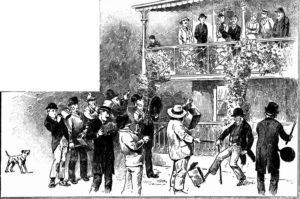
It comes from page 8 of the Sydney Mail & New South Wales Advertiser of 18 December 1886,
where it was one of a series that purported to illustrate ‘A Country Wedding’.
The accompanying article (on page 26 of the same issue) described the tin-kettling
depicted.
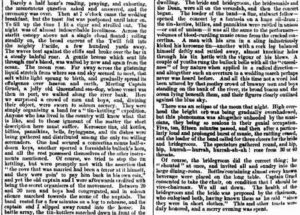
Read the entire article here
Note that the humble kerosene tin featured prominently in both illustration and text.
Here’s an example the genuine article – from its undented condition, evidently not
used in tin-kettling – from the collection of the National Museum of Australia.
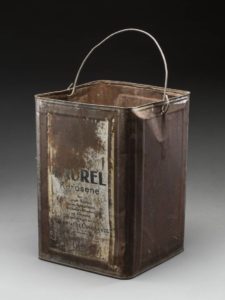
Something I ran out of time to mention in the podcast was the other kinds
of tin-kettling reported in 19th-century Australian newspaper. Dogs were
relentlessly tin-kettled, for ‘fun’, by having tin kettles tied to their tails. And
the tin-kettling of bees was a traditional (if rarely effective) method of coaxing
a swarm back to the hive. Here’s a report of an apicultural tin-kettling – or
tanging – from the Mount Alexander Mail in 1872.
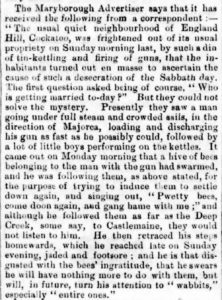
Illustrations of colonial tin-kettling are hard to come by. But here’s one,
from the Sydney Mail & New South Wales Advertiser on 15 February 1905 –
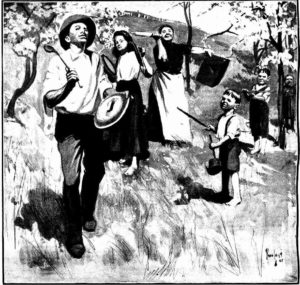
By illustrator Fred Leist, it accompanied ‘An Unexpected Swarming’, Chapter VII
of the Sydney Mail Prize Story, ‘Children of the State’ by John Primrose –
‘…and then into view came the queerest procession. In the lead, the preacher, beating
a boiler lid with an old iron spoon as though his life depended on it; nearest to him, Ruth,
with uprolled sleeves, clanging two saucepan lids together like any Miriam of old; third
on the list, and panting with the exertion of carrying a kerosene bucket in one hand and
banging it with the rolling-pin held in the other, walked and half trotted Aunt Susan, and
lastly, in the rear, in the van, and every where, able for once to make all the row they liked,
were the children, seven all told, and trebling for noise the three adults. No one took any
notice of ‘the little teacher’ as the procession swept by. Their eyes were on ‘Cousin Dan,’
and his on a thin black cloud that buzzed and fluttered before him…’
Read the whole thing here
And finally, here’s the very last account of full-throated tin-kettling
I turned up at Trove Newspapers, from page 46 of Sydney’s Daily Telegraph
on 8 March 1953 (read the whole report here) –

and the cartoon that accompanied it –
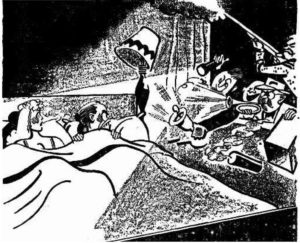
Buried Treasure
Podcast: Play in new window | Download (Duration: 35:23 — 12.6MB) | Embed
Subscribe: Apple Podcasts | RSS | More
Wherein we entertain tales of treasure and avarice.

Men Dig in Richmond Yard And Carry Away – What?
(the question-mark, perhaps)
Sun News-Pictorial, 27 March 1936, p. 4 (copied from microfilm at State Library Victoria)
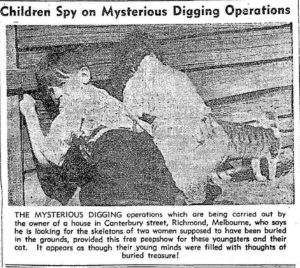
Children Spy on Mysterious Digging Operations (News (Adelaide), 30 March 1936, p. 3)
https://trove.nla.gov.au/newspaper/page/11034096
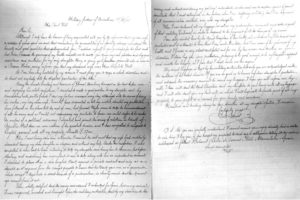
One of the Spanish Prisoner letters found by historian Robert Whitaker in the
British National Archives. Purportedly written by one Luis Ramos, it was received
in 1905 to Paul Webb, a London shopkeeper.
Take a closer look and read Whitaker’s article, Proto-Spam: Spanish Prisoners and Confidence Games,
and see more examples here, from the archives of Plymouth Libraries.
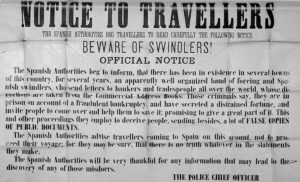
Warning issued by the Spanish Government in 1908
– National Archives (UK): HO 45-10500-120541
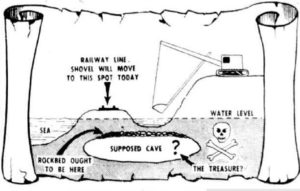
The hunt at Queenscliff for Benito Benita’s treasure – if only it were that easy.
(Herald, 24 March 1954, p. 3). Read the full account here
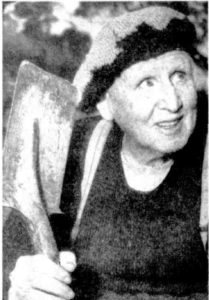
Mr Don Nicholson with his favourite spade (Herald, 8 April 1954, p. 12)
See more photos of his treasure-digging venture here
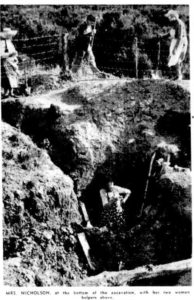
Three Women Dig for Treasure Charter – Lillian Nicholson and her sisters
continue the search (Herald, 20 December 1954, p. 5) See it on the page here
Got the treasure bug? Find links to stories about the fabulous
Wiberg’s Gold here and also here
Agnes & Geraldine – Season 2: ep. 1
Podcast: Play in new window | Download (Duration: 30:31 — 11.0MB) | Embed
Subscribe: Apple Podcasts | RSS | More
Wherein we drill down on a fin-de-siècle folly.
Welcome to Season Two of Nothing on TV. Here’s how it begins…
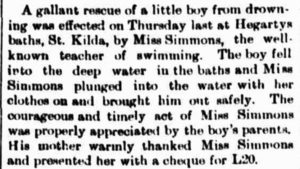
Herald (Melbourne), 19 February 1887, p. 2, col. 7
Read the article in situ here
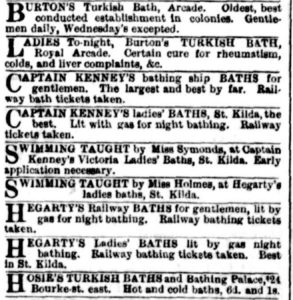
Argus (Melbourne), 3 February 1882, p. 8, col. 5
Could the ‘Miss Symonds’ teaching swimming at Captain Kenney’s
ladies’ baths have been our Miss Simmons, lately transplanted from Blueskin Bay, NZ?
Dive into the aquatic adverts here
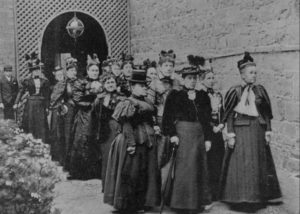
Whither Miss Simmons? Might she be among this circa-1880s deputation
of Victorian suffragists?
Photo courtesy Victorian Women’s Trust
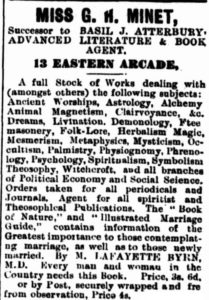
Oakleigh Leader, 20 August 1892, p. 8, col. 5
Or take a look for yourself here
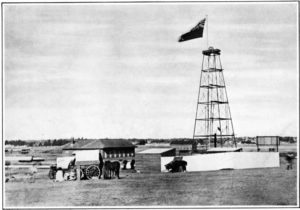
The Red Bluff coal mine, 1895. ‘Helena’ the steam engine lived in the shed
to the fore of the poppet-head.
from John Butler Cooper’s The History of St Kilda, vol. 1, 1931
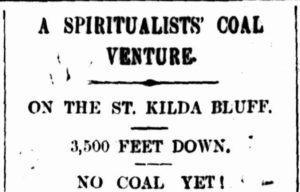
Argus (Melbourne), 16 December 1895, p. 5, col. 2
Read the full report, revealing the Misses Simmons and Minet’s part in the
venture, here
And finally, be sure to take a look at Papers Past , the National Library of New Zealand‘s
fabulous digital repository of historical newsprint and more.

The Suburban Ghost – ep. 7 (season finale)
Podcast: Play in new window | Download (Duration: 30:51 — 11.1MB) | Embed
Subscribe: Apple Podcasts | RSS | More
Wherein we encounter a ‘phosphorescent charmer’ in fin de siècle Melbourne .
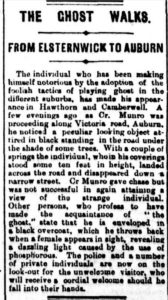
Herald (Melbourne), 8 August 1892, p. 2, col. 8
See it on the page, here.
Did you know that The day the ghost walks is slang for pay-day? Originally theatrical slang,
it supposedly originated among the cast of an early production of Hamlet. Much later, it would
come into more general use, though mainly in the US.
And speaking of the theatre, Melbourne’s suburban ghost went on to share a bill with a
lady contortionist in a ‘screamingly funny farce’ –
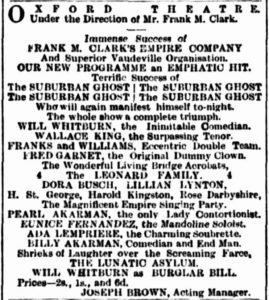
Argus (Melbourne), 5 August 1895, p. 8, col. 7
Like to know more about the legend of Spring-heeled Jack, the (not-quite) original
suburban ghost? For a brief run-down, take a look at the Atlas Obscura entry – chances are
you’ll find plenty more at Atlas Obscura to snag your interest. Or for the (obsessively) full story
(on an orange background, no less), immerse yourself in The Complete Spring Heeled Jack Page
– just don’t say I didn’t warn you.
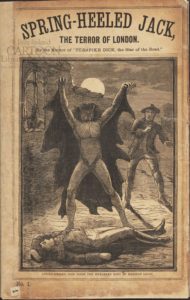
Spring-Heeled Jack, The Terror of London No. 1.
From the San Francisco Academy of Comic Art, the Ohio State University Billy Ireland Cartoon Library & Museum.
This ‘penny dreadful’ series ran to at least 36 issues. See more of the covers here.
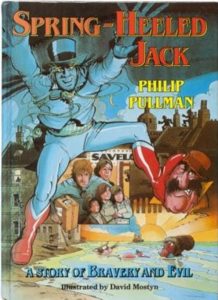
Cover of Spring-Heeled Jack, a 1991 graphic novel for kids by Phillip Pullman, who would go on to write
the acclaimed ‘His Dark Materials’ trilogy for young adults. And speaking of daemons…
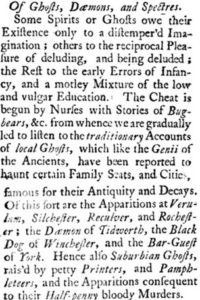
Universal Spectator (London), 7 October 1732
This is the earliest mention I’ve been able to find of ‘suburban ghosts’.
The suggestion here seems to be that such ghosts are ‘raised’ (i.e., invented) by
‘petty Printers and Pamphleteers’ in order to sell more papers – a suggestion
echoed in a regional Australian newspaper 173 years later:
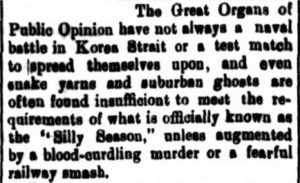
Dubbo Liberal & Macquarie Advocate (NSW), 10 June 1905, p. 6, col. 4
The Hatpin Menace – ep. 6
Podcast: Play in new window | Download (Duration: 34:33 — 12.4MB) | Embed
Subscribe: Apple Podcasts | RSS | More
Wherein we consider the point of hatpins.
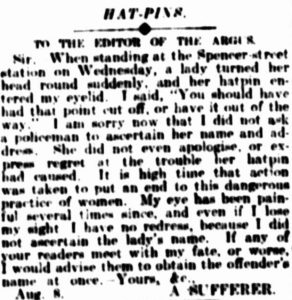
Argus (Melbourne), 9 August 1911, p. 14, col. 4
Or read the whole page here
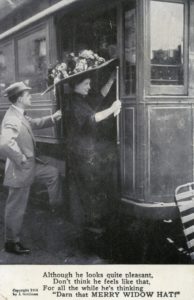
A comic postcard from 1907.
I found it at http://whatsinthetrench.weebly.com/blog/archives/09-2016
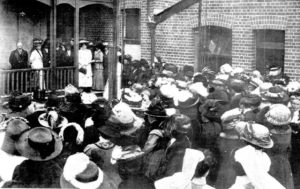
Here’s some hats, at the opening of the new nurses’ quarter, Queen Victoria
Hospital, Melbourne – from the Weekly Times, 15 April 1911, p. 27
Take a look here at other photos from this terrific illustrated newspaper.
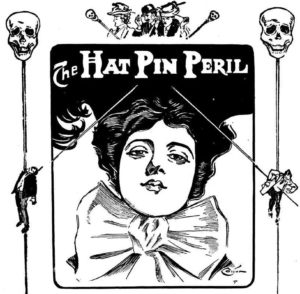
The World’s News (Sydney), 11 May 1907, p. 1
Read the story here.
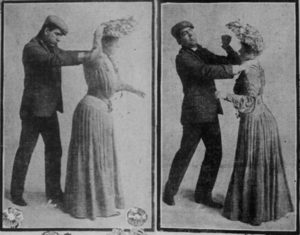
‘Here’s something for you!’ The hatpin in self-defence.
Image: Wikimedia Commons
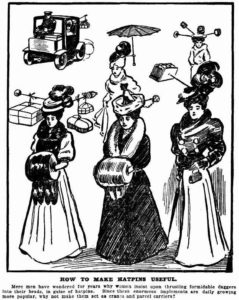
How to Make Hatpins Useful
Evening News (Sydney), 16 March 1907, p. 10
Click here to see it on the page.
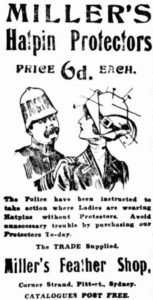
A head like a Sputnik
Evening News (Sydney), 23 May 1912, p. 11
See it here among other ads of the day
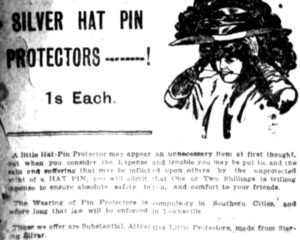
Townsville Daily Bulletin, 17 October 1912, p. 2
See all the Townsville news here
Deadwood Dick & the Picture Show Panic – ep. 5
Podcast: Play in new window | Download (Duration: 28:28 — 10.3MB) | Embed
Subscribe: Apple Podcasts | RSS | More
Wherein we learn who to blame for the perennial naughtiness of boys.
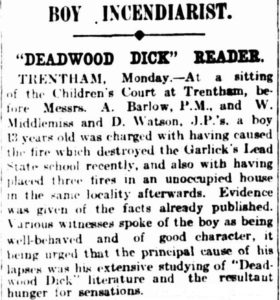
Argus (Melbourne), 10 November 1914, p. 8, col. 2
Read it in full here
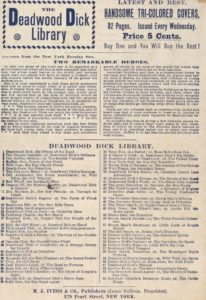
Titles in the Deadwood Dick Library – ‘Issued Every Wednesday. Price 5 cents’
From the ‘Nickels and Dimes’ collection of Northern Illinois University Libraries
– click here to access the whole collection.
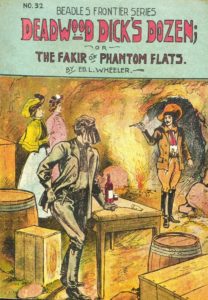
Here we see Deadwood Dick’s distinctive ‘vail’, ‘through the eye-holes of which
there gleamed a pair of orbs of piercing intensity’.
This cover features in Haverford College (Pennsylvania) Library’s online exhibition,
The Second Generation: Boy Heroes in American Dime Novels, 1860-1910.
View the whole thing here
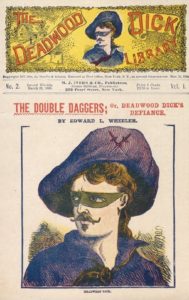
Here we have Dick from a later series, wearing a modified mask more fitting for a superhero.
(From the ‘Nickels and Dimes’ collection of Northern Illinois University Libraries)
Click here to view the whole book
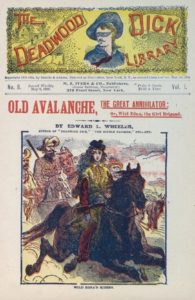
Wild Edna, the Girl Brigand
(from the ‘Nickels and Dimes’ collection of Northern Illinois University Libraries)
Click here to view the whole book
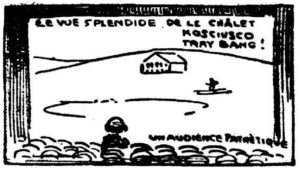
Le vue splendide de le châlet Kosciusco tray bang! [ersatz French for tres bien]
Un audience patrètique [patriotique]
‘Why should scenic pictures be picked out as specially suitable, unless dullness is presupposed as
necessarily just the thing for Sunday evening? Can the Acting-Chief Secretary seriously hold that
a picture of Kosciusko or Katoomba or Mullengudgerie or Stockinbingal encourages a devotional
frame of mind?’
The World’s News (Sydney) on the restricting of Sunday picture shows – 10 June 1911, p. 15, col. 3
Read the whole article for yourself here
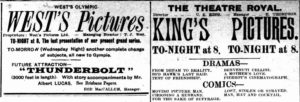
What’s on in Gympie – Gympie Times (Qld), 3 January 1911, p. 2
View the whole page here
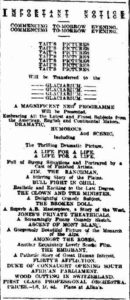
A typical picture-show program from 1911 – Age (Melbourne), 3 January 1911, p. 10, col. 6
Read it up close here, along with adverts for other picture shows, and for the vaudeville shows
and waxworks that were on the brink of redundancy.
Click here for an entire page of moving picture previews and gossip from the Sunday Times (Sydney) in 1914.
Champagne & Anarchy – ep. 4
Podcast: Play in new window | Download (Duration: 28:19 — 10.2MB) | Embed
Subscribe: Apple Podcasts | RSS | More
Wherein we have our cockles warmed by Lord Hopetoun’s liquid largesse, as dispensed by an anarchist on the mean streets of Melbourne in 1902.
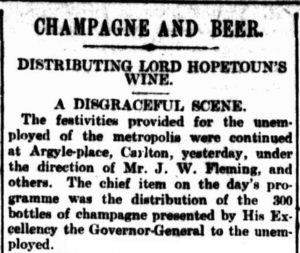
Argus (Melbourne), 26 June 1902, p. 5, column 3
Read the whole of the report, plus all that day’s news (including the king’s illness) here.
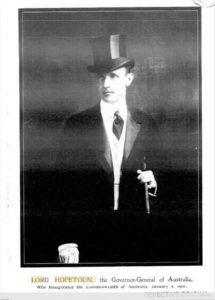
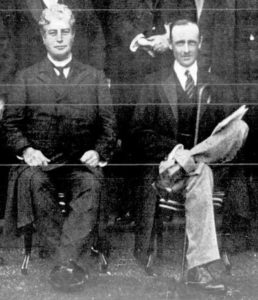
Critic (Adelaide), 5 January 1901, p. 3 Australasian, 12 January 1901, p. 29
(Left) An official 1901 portrait of the G-G. Note the stamp, defective original, at the foot of the page. This
seems to refer to the newspaper, not Lord Hopetoun – notwithstanding views expressed in the Barrier Miner.
(Right) His Excellency’s safari pants and yoga pose strike an informal note, compared with Prime Minister
Edmund Barton’s dress-suit, in a photo taken following the swearing-in of Australia’s first federal cabinet.
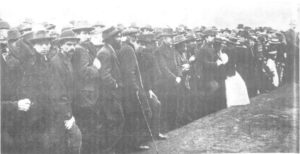
The crowd in Argyle Place, Carlton, on the morning of Wednesday, 25 June 1902.
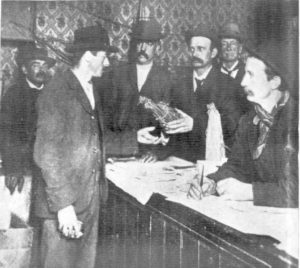
‘Mr Fleming hands out the first bottle of Lord Hopetoun’s gift (25 dozen champagne)’
To qualify for a bottle, you had to have a ’tache. Note that the bottle is still packed for shipping
in a protective coating of… could they be grapevine cuttings?
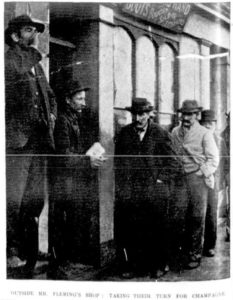
A queue (possibly those troublesome Smiths) outside the bootshop.
One of Chummy Fleming’s confederates (left) shouts the next name on the list.
The above three photos come from the Australasian, 5 July 1902, p. 28
Take a closer look here – you’ll notice that, at the bottom left-hand corner of the page, a photo of the
bacchanal at the beer barrels has been partly torn out of the copy of the Australasian that was digitised.
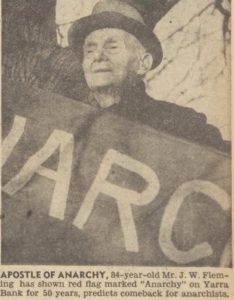
Australian Women’s Weekly, 27 September 1947, p. 25
J.W. (Chummy) Fleming, still waving the flag at Melbourne’s Yarra Bank speakers’ corner in 1947, three years before his death.
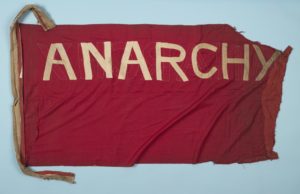
And here is that flag – now in the Realia Collection of the State Library of Victoria (Accession no: H89.109/2)
Have you seen my poncho cloak? – ep. 3
Podcast: Play in new window | Download (Duration: 28:13 — 10.2MB) | Embed
Subscribe: Apple Podcasts | RSS | More
Wherein we plunder drapers’ shops, cloakrooms, and the Lost & Found column in search of the poncho cloak and its shoddy brethren.
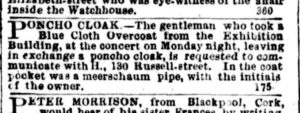
Argus (Melbourne), 23 June 1855, p. 1, column 6
Or take a look here at what else was lost and found that day
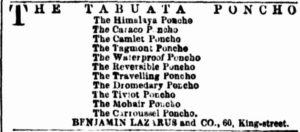
The full poncho range of Benjamin Lazarus & Co., Sydney drapers
– Sydney Morning Herald, 12 June 1855, p. 8, column 6
Click here to compare Lazarus’s stock with that of his competitors,
or here to read what his persuasive rival, Mr Marks, had to offer
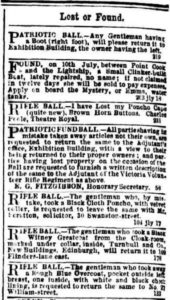
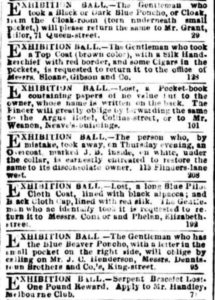
Argus (Melbourne), 16 July 1855, p. 6, columns 6 & 7
Read click here to follow the fall-out of the cloakroom cock-up at the Patriotic Fund Ball
Or, for a different perspective…

I’ve searched in vain for an image of a contemporary poncho cloak
(an Inverness cape just doesn’t cut it), so you’ll have to make do with this –

Australian Women’s Weekly, 16 June 1971,
‘Knits for Action’ supplement, p. 14
Yeah! That’s how we did things in the ’70s. Well, actually… this is how we did things –
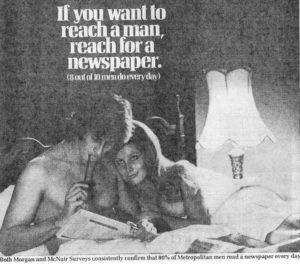
(cut out of an actual newspaper – source forgotten!)
The Marble Man – ep. 2 (part 1)
Podcast: Play in new window | Download (Duration: 21:34 — 7.9MB) | Embed
Subscribe: Apple Podcasts | RSS | More
Wherein we trace the curious career and prehistory of a ‘petrified man’ dug out of a New South Wales marble quarry.
See post for The Marble Man part 2 for further reading and links for this two-part episode.
The Marble Man – ep. 2 (part 2)
Podcast: Play in new window | Download (Duration: 17:26 — 6.5MB) | Embed
Subscribe: Apple Podcasts | RSS | More
Wherein we continue to trace the curious career and prehistory of a ‘petrified man’ dug out of a New South Wales marble quarry.
Further reading and links for this episode:
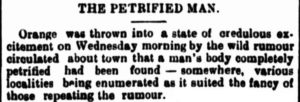
Bathurst Free Press & Mining Journal, 21 May 1889, p. 2, columns 4-5
Read the full article in situ and see what else was happening in district news that week.
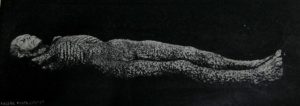
from The Legend of the Petrified or Marble Man by Harry Stockdale, F. Cunninghame & Co., Sydney, 1889
Read the book online

The Cardiff Giant, on display at the Bastable in Syracuse, NY, circa 1869
(New York State Historical Association Library)
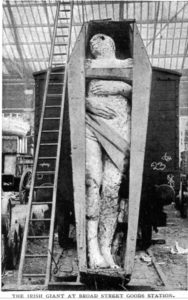
The petrified Finn McCool, the Causeway Giant
from The Strand Magazine (London), vol. X, July to December 1895, p. 646 (digitised by archive.org)
See that photo in situ, featured in the fascinating article, ‘The Lost Property Office’
And finally – click here to view images of Pompeii bodies, cast in plaster
Enter the Elephant – ep. 1
Podcast: Play in new window | Download (Duration: 15:31 — 5.8MB) | Embed
Subscribe: Apple Podcasts | RSS | More
Wherein we chart the declining fortunes of a performing elephant in goldrush-era Victoria.
Further reading and links for this episode:
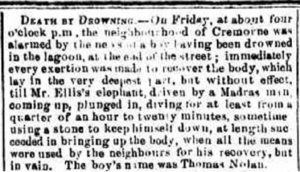
Age (Melbourne), 7 November 1854, p. 5 – or read it in situ (look at the top of column 5),
to see what else was happening in the news that day.
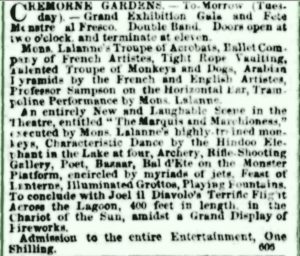
Argus (Melbourne), 16 October 1854, p. 8 – or read it in situ (column 5),
to discover what else was on in Melbourne that week.
Click here to read an article looking back at the Cremorne Gardens of the 1850s & ’60s,
from the Melbourne Argus, 8 April 1933, p. 6


